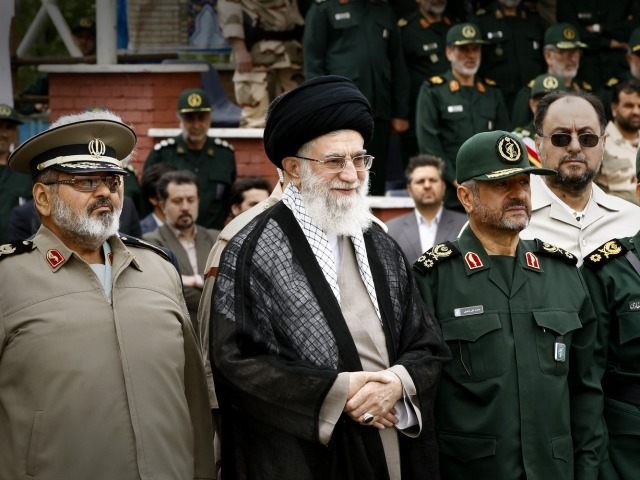TEHRAN, Iran (AFP) — Iran’s Revolutionary Guards chief announced the “end of the sedition” Wednesday as tens of thousands rallied in a show of strength for the country’s Islamic rulers after days of deadly unrest.
General Mohammad Ali Jafari said the Guards only intervened “in a limited way” against fewer than 15,000 “trouble-makers” nationwide, adding that a large number had been arrested.
Protests over economic problems broke out in Iran’s second city Mashhad on December 28 and quickly spread across the country, turning against the regime as a whole.
A total of 21 people have died in the unrest, with protesters attacking government buildings and police stations in some areas.
“Today we can announce the end of the sedition,” Jafari said, quoted on the Guards’ website.
“A large number of the trouble-makers at the center of the sedition, who received training from counter-revolutionaries… have been arrested and there will be firm action against them,” he said.
Jafari spoke after thousands of pro-regime demonstrators took to the streets.
Chants of “Leader, we are ready” were heard as images showed thousands rallying in the cities of Qom, Ahvaz, Kermanshah and elsewhere.
The demonstrators waved Iranian flags and pictures of supreme leader Ayatollah Ali Khamenei, as well as placards saying “Death to seditionists”.
Social media blocked
AFP journalists reported a heavy police presence was still on the streets of Tehran, along with a large number of Revolutionary Guards.
General Jafari added those behind the protests had “intervened massively on social media” but that “once restrictions were started, the troubles reduced.”
Telegram and Instagram were blocked on cellphones soon after the protests began on December 28.
Telecoms Minister Mohammad-Javad Azari Jahromi said Telegram would only be unblocked if it removed “terrorist” content.
“I had mail exchanges with the head of Telegram and I told him that the continuation of Telegram’s activities is conditioned on the suppression of terrorist content,” he said.
There were few reports of anti-regime protests overnight, although it remained difficult to verify information from the provinces.
President Hassan Rouhani expressed hope in a phone call with Turkish counterpart Recep Tayyip Erdogan that the protests would end in a few days, a Turkish presidential source said.
The political establishment has closed ranks against the unrest, saying the protests were part of a foreign plot to destabilize the regime.
“The enemy is always looking for an opportunity and any crevice to infiltrate and strike the Iranian nation,” Khamenei said on Tuesday.
US exerts pressure
US President Donald Trump said Iranians were trying to “take back” their government, extending a drumbeat of encouragement for the protests.
“You will see great support from the United States at the appropriate time!” he tweeted, without offering any specifics.
UN human rights chief Zeid Ra’ad Al Hussein called on the Iranian authorities to defuse tensions and investigate the deaths.
“It is incumbent on the authorities that their actions do not provoke a downward spiral of violence, as occurred in 2009,” he said in reference to the last major protest movement against alleged election-rigging.
Even reformists in Iran, who backed the 2009 protests, have condemned the violence and the support the demonstrations have received from the United States.
But they also urged the authorities to address economic grievances.
“Officials must acknowledge the deplorable situation of the country as the first step to hearing the protesters,” tweeted Mohammad Taghi Karroubi, whose father Mehdi Karroubi has been under house arrest for almost seven years for helping lead the 2009 demonstrations.
Many have been turned off by the violence, which has contrasted with the largely peaceful marches in 2009.
But on the streets of the capital, there is widespread sympathy with the economic grievances driving the unrest, particularly an unemployment rate as high as 40 percent for young people.
‘Poor under pressure’
“The poorer section of society is really under pressure,” Sakineh Eidi, a 37-year-old pharmacist in Tehran, told AFP. “But I don’t think it will continue.”
“Even those who maybe acted emotionally, vandalizing things and setting fire to public property, know that the smoke will get into everyone’s eyes and that insecurity in the country is not in anyone’s interest.”
Others rejected the official line that foreign powers were behind the unrest.
“People have reached a stage where they can no longer tolerate this pressure from the authorities,” said Soraya Saadaat, a 54-year-old jobless woman.
Mojtaba Mousavi, a Tehran-based political analyst, said Iranians do not generally support violence, no matter how unhappy they are with their government.
“There are certainly Iranians who aren’t happy with certain policies, frustrated people who would like to protest against their economic situation, but history shows none of these people support violence and subversion,” he said. But “this week’s protests turned into riots.”
Iranian President Hassan Rouhani speaks in a cabinet meeting in Tehran, Iran, December 31, 2017. (Iranian Presidency Office via AP)
Rouhani came to power in 2013 promising to mend the economy and ease social tensions, but high living costs and unemployment have left many feeling that progress is too slow.
Rural areas, hit by years of drought and under-investment, are particularly hard-hit.
Rouhani on Sunday acknowledged there was “no problem bigger than unemployment,” and also promised a more balanced media and more transparency.
In 2009, authorities ruthlessly put down protests against the re-election of hardliner Mahmoud Ahmadinejad. At least 36 people were killed, according to an official toll, while the opposition says 72 died.

COMMENTS
Please let us know if you're having issues with commenting.